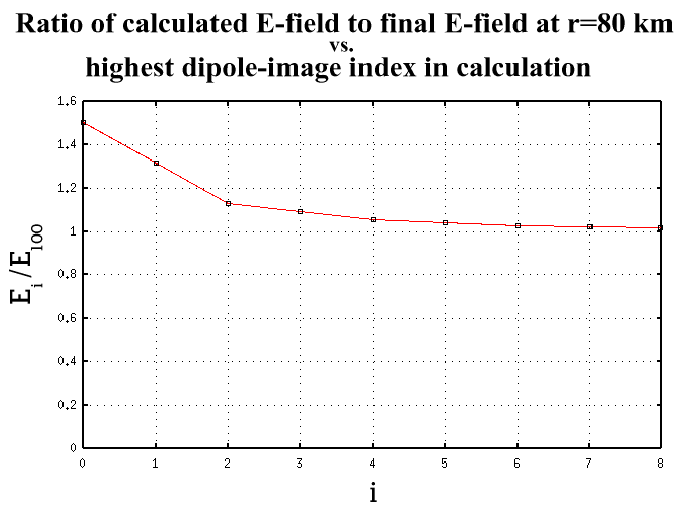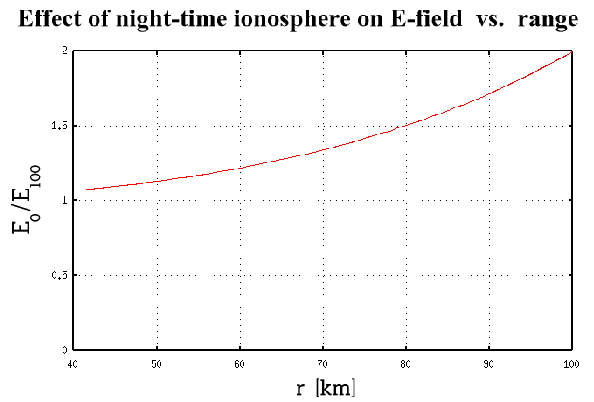 |
It was shown in Section 2.5.1 that charge images due to the presence of the ionosphere increased the electric field above the source charge. It was also shown that the total number of images in a static electric field calculation was infinite, though the electric field rapidly converged with increasing image index to a final value at altitudes where sprites were likely to initiate. In this section, the effect of ionospheric images on static electric field observations near the ground at some distance from the source will be examined. The image index notation will be the same as in Figure 2.7a.
The distance to the estimated charge removal center of the sprite-producing discharges listed in Table 3.1 was about 80 km. Figure C.1 shows the convergence of the calculated electric field at 80 km range to a ``final'' electric field value as a function of the image index. Unlike the electric field at high altitude (see Figure 2.7b), the electric field at ground level is decreased by the presence of the ionosphere.
 |
The calculated electric field converges to a final electric field
value in Figure C.1, but the rate of
convergence at a range of 80 km at ground level is slower than the
rate of convergence at an altitude of 78 km MSL above the discharge
(see Figure 2.7b). However, one should not
use a large summation when attempting to determine a charge moment
from an observed electric field since the images are not set up
instantaneously. Rather, each successive image is delayed by at least
the light propagation time between the ground and the ionosphere
(
![]() ms).
ms).
In order to calculate the charge moments in Table 3.1
at delays of 1 and 4 ms after the return stroke, the product of the
number of images with the light propagation time between the ground
and ionosphere was not allowed to be greater than the post return
stroke delays. To complicate matters, the charge moment of the
sprite-producing discharges increased throughout the interval after
the return stroke instead of being ``suddenly'' introduced at ![]() .
Thus, the number of images used in the static field calculation had to
reflect the fact that some of the quasistatic electric field change
might have occurred with less time for images to form relative to
earlier portions of the field change. For the 1 ms delays, the
highest image index included in the charge moment calculation shown in
Table 3.1 was 3. The highest image index for the 4 ms
delays was 7.
.
Thus, the number of images used in the static field calculation had to
reflect the fact that some of the quasistatic electric field change
might have occurred with less time for images to form relative to
earlier portions of the field change. For the 1 ms delays, the
highest image index included in the charge moment calculation shown in
Table 3.1 was 3. The highest image index for the 4 ms
delays was 7.
Near the source charge the effect of the ionosphere can be neglected
since the electric field from the charge will dominate. As the range
to the source is increased, the effect of the ionosphere images will
become increasingly important. The ratio of the electric field
calculated without the presence of an ionosphere, ![]() , to the
``final'' electric field,
, to the
``final'' electric field, ![]() , is shown as a function of range
in Figure C.2. At 40 km range, the ionosphere only
decreases the static electric field by at most 7%. At 100 km range,
however, the ionosphere reduces the static electric field by about a
factor of two.
, is shown as a function of range
in Figure C.2. At 40 km range, the ionosphere only
decreases the static electric field by at most 7%. At 100 km range,
however, the ionosphere reduces the static electric field by about a
factor of two.
 |